After a long winter, it’s a harbinger of spring when flowering dogwood (Cornus florida) trees begin to bloom. Flowering dogwoods are one of the first trees to bloom in the springtime. Fragrant star-shaped flowers appear in early March before the leaves pop out on the branches. When the flowers fade, reddish-orange fruits take their place. Hungry birds will be drawn to your dogwoods to eat the berries. In the fall, the foliage of the flowering dogwood turns from green to varying hues of red and purple. As winter approaches, the bark of the flowering dogwood takes on a visually interesting rough texture. No wonder flowering dogwoods are treasured by so many plant lovers and landscapers!
With such great beauty comes a host of potential difficulties. Flowering dogwoods are sensitive and susceptible to a number of diseases and pests that can turn your gorgeous tree into an eyesore. Put on your detective hat! Let’s investigate what can make your flowering dogwood look so sick.
1. Leaf Scorch
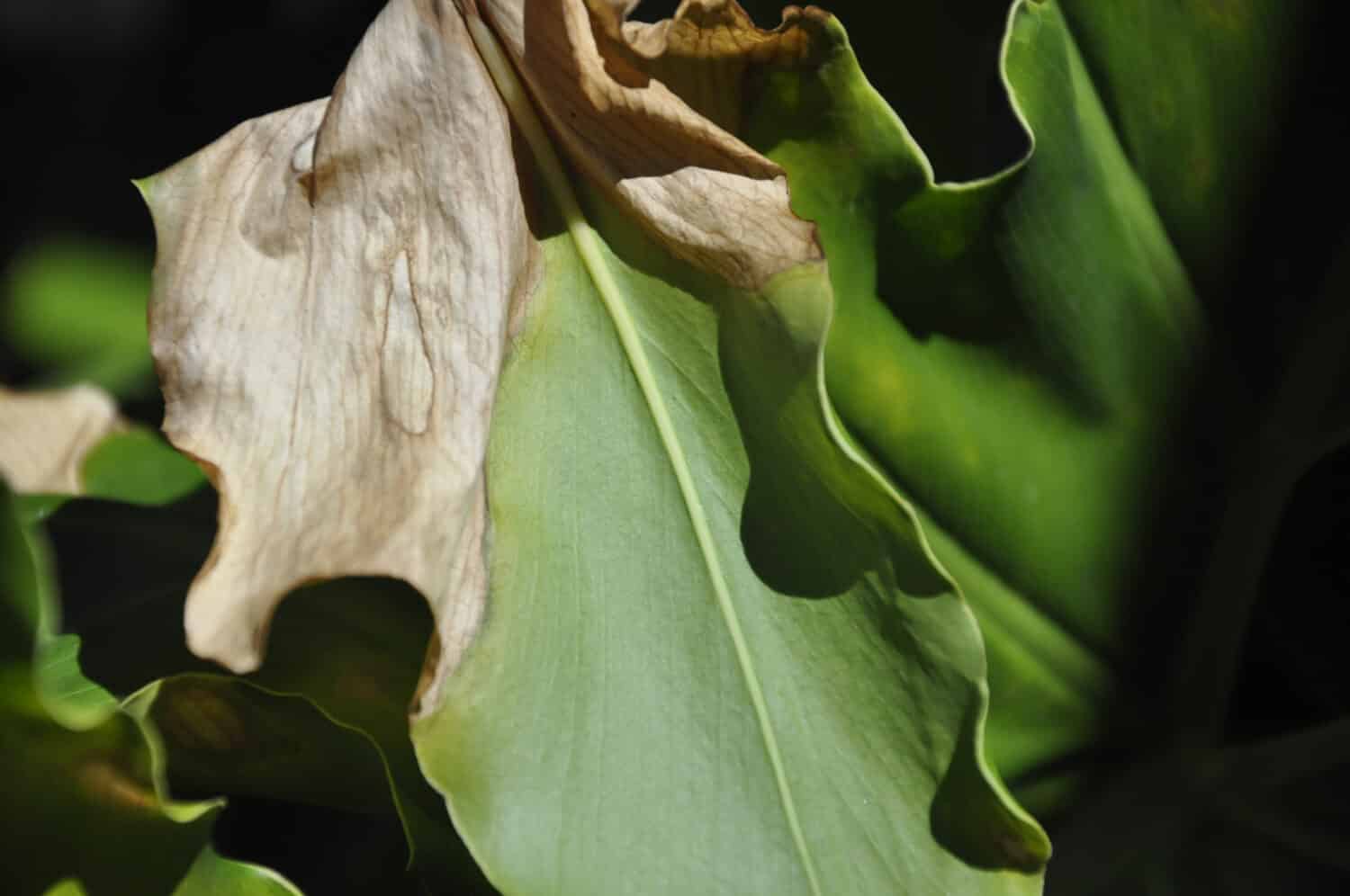
Regardless of which plant it affects, leaf scorch takes away from its natural beauty.
©Pete Holley/Shutterstock.com
In hot weather, the edges of flowering dogwood leaves may turn brown and curl up. This condition is known as leaf scorch. Heat can cause the leaves to lose more water through evaporation than they receive from the roots, causing them to look withered. Although leaf scorch can impair flowering dogwoods, it is not a fatal condition. Make sure your flowering dogwoods are planted in partial shade. During the summer, keep the soil around flowering dogwoods slightly moist. Place one to two inches of mulch around the tree to improve moisture retention and keep the roots cool.
2. Overwatering
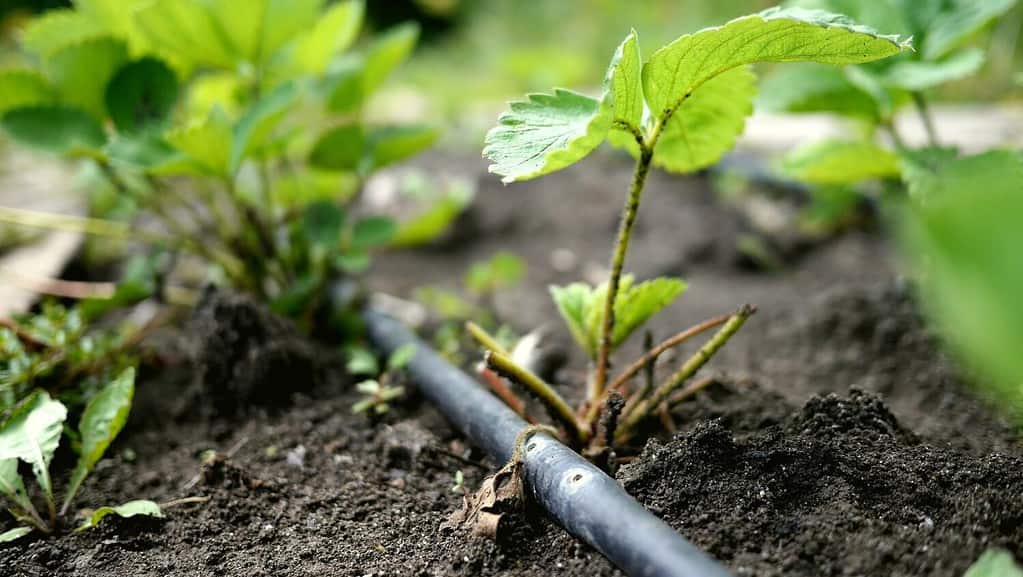
Soaker hoses are great for watering flowering dogwoods as long as the soil drains well.
©Nadeene/Shutterstock.com
Giving flowering dogwoods too much water or planting them in soil that remains moist causes them to become ill. Oversaturated roots are unable to provide proper nutrients to the tree. Leaves wilt, turning yellow and brown. Too much moisture creates ideal conditions for root rot, a disease that causes flowering dogwood roots to decay. If you suspect overwatering is causing issues with the health of flowering dogwoods, then reconfigure your watering schedule. Flowering dogwoods perform best in well-draining soil. Consider amending the soil with gravel to improve drainage around flowering dogwoods. If feasible, transplant the flowering dogwoods to an area with better soil conditions.
3. Dogwood Borer (Synanthedon scitula)
Wounded trees are vulnerable to the larvae of the dogwood borer, a clearwing moth that looks like an aggressive stinging insect. Adult dogwood borers are active from May until October. During that time, female adult dogwood borers lay eggs on the injured sites of flowering dogwood trees. Within two weeks, the eggs hatch, and the larvae infest the tree through the trunk’s wounds. As the name indicates, the larvae dig their way through the bark, feeding as they go. Their feeding causes the bark to fall from the tree. Undiscovered, dogwood borers may travel all the way around the tree beneath the bark. If the cambium (where new plant cells are created) is destroyed by dogwood borers, the tree will die.
In the late winter, cut off infested branches and destroy them. Borers can be removed from flowering dogwoods with a knife. Run a stiff wire into the feeding tunnels and crush the larvae. Consult with your local county extension office for guidance on using pesticides.
4. Dogwood Twig Borer (Oberea tripunctata)
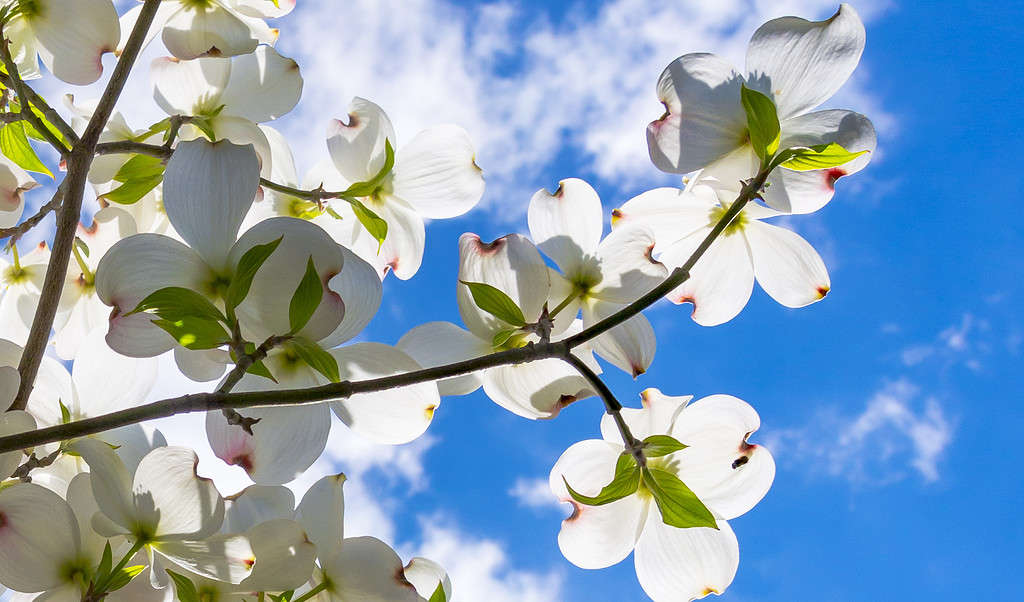
Check the junctions of twigs and branches for the telltale holes of dogwood twig borer infestation.
©WendellandCarolyn/iStock via Getty Images
Utilizing burrowing behavior on a smaller scale, the dogwood twig borer attacks flowering dogwood branches. A variety of longhorn beetle, the dogwood twig borer chews a series of holes in the crooks of flowering dogwood branches. Mature female dogwood twig borers lay eggs in the holes. When the eggs hatch, grubs work their way beneath the bark and begin eating. The resulting damage kills the twig. After overwintering inside the twig, mature dogwood twig borers emerge the following spring.
Infestation by dogwood twig borers weakens the flowering dogwood, but does not kill the tree. Infestations can be controlled by the application of pyrethrin-based insecticide. Affected twigs should be removed from the tree and burned.
5. Dogwood Clubgall Midge (Resseliella clavula)
Have you seen large abnormal growths on the branches of flowering dogwoods? If so, that tree may be host to the dogwood clubgall midge. Put simply, dogwood clubgall midges are small flies. In the spring, mature females lay their eggs in the leaf buds of flowering dogwood trees. When the maggots hatch, they begin feeding on the tree. Saliva produced by their feeding activity creates a gall, which is a protuberance on the twigs. Maggots remain in the gall until the end of summer when they gnaw their way free and fall to the ground below. Dogwood clubgall midges overwinter beneath the flowering dogwood and enter a pupal stage. Adults emerge in the spring and the cycle repeats.
Some people dislike the appearance of galls in flowering dogwoods while others find them aesthetically pleasing. However, allowing an infestation of dogwood clubgall midges can do harm to a tree. The easiest way to rid flowering dogwoods of dogwood clubgall midges is by pruning. After the larvae have deserted the galls, snip off the affected twigs.
6. Dogwood Sawfly (Macremphytus tarsatus)
Voracious eaters, dogwood sawflies love to chow down on flowering dogwood leaves, making your tree look ragged and ill. In the early summer, mature dogwood sawflies lay their eggs on the underside of dogwood leaves. When the eggs hatch, they begin to eat the leaves. Newly-hatched larvae look like caterpillars. They go through molts which change their appearance. In between their second and final molt, dogwood sawflies become covered with a white, waxy material. Viewed from afar, they look like bird droppings on the flowering dogwood leaves. Because the larvae feed on the leaves as a group, rapid defoliation occurs leaving nothing but leaf veins and the central midrib.
Although the leaves fall prey to the hungry dogwood sawfly larvae, the tree itself is often left unharmed. At the beginning of summer, check the underside of flowering dogwood leaves for eggs along the midrib. Remove and destroy those leaves before the eggs hatch. If you discover the caterpillar-like larvae, shake the tree until they fall down. Placing them in a bucket of soapy water kills them, as does stepping on them. Spraying neem oil on the underside of the leaves will force older larvae to find somewhere else to feed.
7. Scale Insects (Coccoidea)
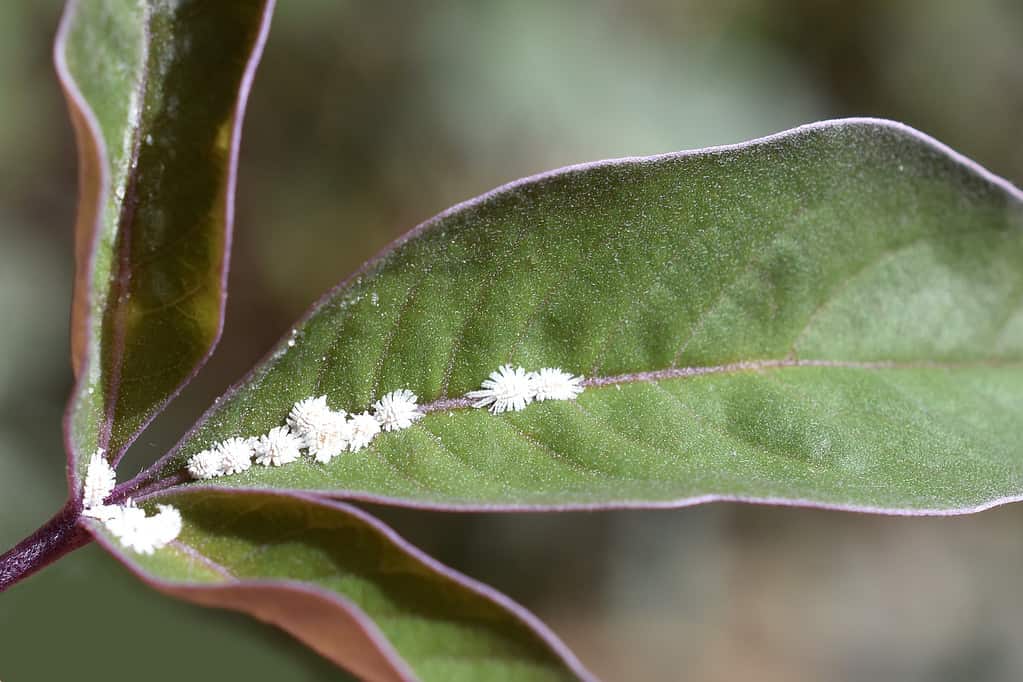
Female scale insects die after laying their eggs.
©HHelene/iStock via Getty Images
Functioning like miniature leeches, scale insects make flowering dogwoods look they have rough dry skin. Rarely growing larger than half an inch, scale insects are covered with a waxy substance. That coating renders most insecticides ineffective. Scale insects pierce flowering dogwoods with sharp mouth parts, allowing them to drink the sap. In response, flowering dogwoods become stunted with yellowing leaves. If enough scale insects feed on flowering dogwoods, the tree could die. There are two groups of scale insects. Soft-scale insects have a pliable cover that is directly attached to the body. Armored scale insects have a hard shell that is not attached to the body. Soft-scale insects produce honeydew, which attracts other potentially harmful insects. Honeydew also gives rise to sooty mold, a fungus that causes portions of the tree and its surroundings to turn black.
Scale insects can be scraped off of flowering dogwoods with a knife or blasted away with a strong stream of water. In the spring, before leaves begin to appear, neem oil can be applied to the flowering dogwood. If the infestation becomes too great, affected branches can be removed from the tree.
8. Tree Aphids (Aphidae)

When under attack by predators, aphids emit pheromones to warn others of danger.
©Oleksandr Shatyrov/iStock via Getty Images
More of a pest than a threat to flowering dogwoods, tree aphids use their piercing mouths to suck sap from trees. You may notice the leaves of flowering dogwoods dripping. That is called honeydew, a liquid secreted by tree aphids. Not only do ants love honeydew, but it can create black patches on flowering dogwoods called sooty mold. Neither dripping leaves nor sooty mold are attractive features!
Because aphids are small, it takes a multitude of them to truly damage a flowering dogwood. Spray the aphids off flowering dogwoods with a strong stream of water. Water washes away the black patches of sooty mold as well. If necessary, spray the affected areas with neem oil.
9. Armillaria Root Rot
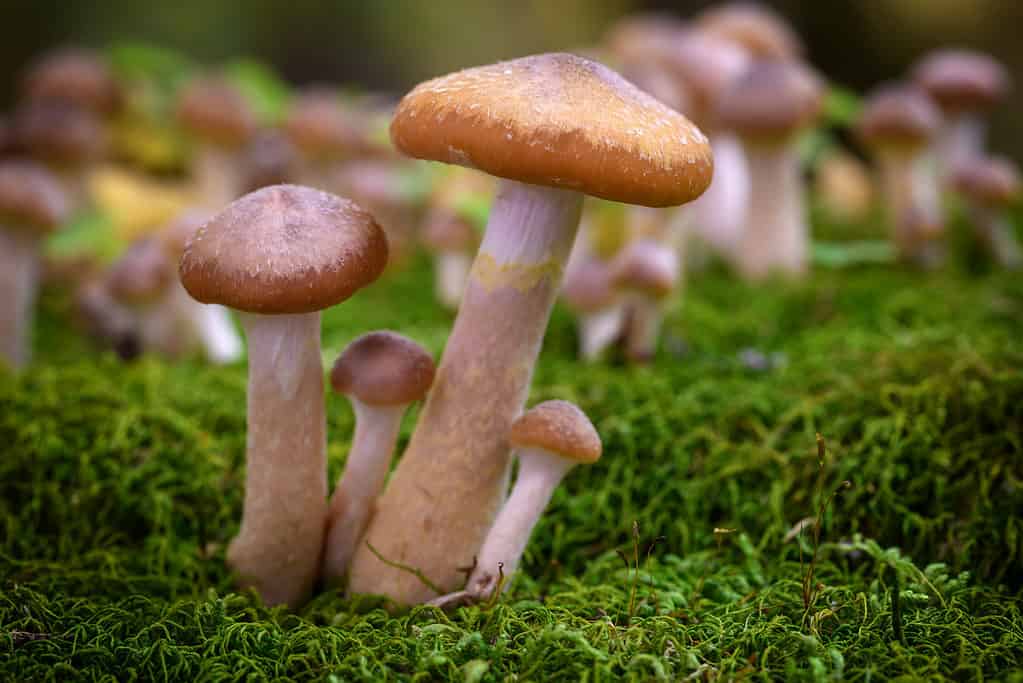
Honey mushrooms are the fruit of the Armillaria fungus.
©Zbigniew Dziok/Shutterstock.com
Able to live underground for years, Armillaria is a fungus that attacks the roots of flowering dogwoods. Once infected, flowering dogwood roots cannot send nutrients to the rest of the tree. Leaves turn yellow and drop off the branches early. Armillaria fungus surrounds the base of the trunk, destroying the tree’s ability to produce new bark. Honey mushrooms growing around the bottom of a flowering dogwood indicate an Armillaria infestation. Once a flowering dogwood is infected with Armillaria root rot, there’s no remedy for it. Remove and destroy the tree.
10. Dogwood Anthracnose (Discula destructiva)
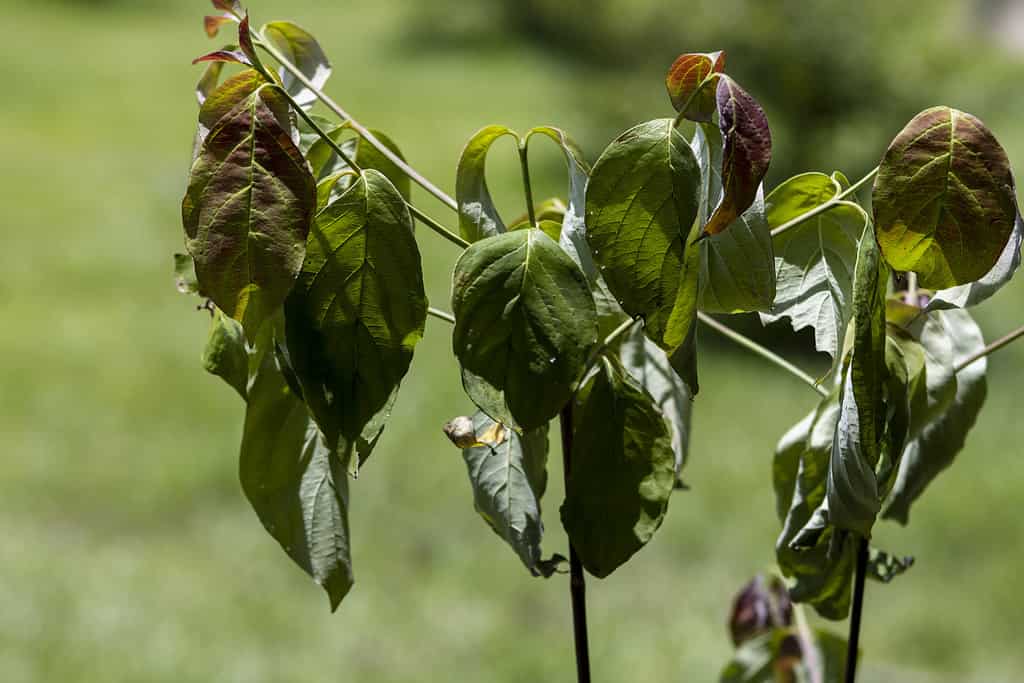
Wilting leaves may be a sign that your flowering dogwood tree has dogwood anthracnose.
©Tim Bingham/iStock via Getty Images
Of all the fungal diseases that afflict flowering dogwood trees, dogwood anthracnose is one of the most lethal. Its origin is unclear, and flowering dogwoods have no natural defenses against it. Signs of infection begin in the leaves, which display brown spots before wilting. Infected leaves may remain on the tree into autumn. From the leaves, dogwood anthracnose spreads into the twigs and branches, killing them. In response, the tree produces shoots on the lower part of the tree. New shoots quickly become infected, carrying dogwood anthracnose into the main trunk. Flowering dogwoods infected with dogwood anthracnose die within three to four years. Cut down and burn flowering dogwoods that have been infected by this fast-acting disease.
11. Collar Rot (Phytophthora cactorum)
Like humans, trees are susceptible to injury. Lawn care equipment, vehicles, and even birds can create holes or gouges in the bark of flowering dogwoods. Those open wounds are the perfect entry point for the fungus called Phytophthora cactorum, which causes a disease called collar rot or crown canker. You’ll notice withered, discolored leaves. Branches begin to die back. Infected areas appear around the trunk of the tree, killing the bark. Black fluid leaks from the affected parts of the tree. In advanced cases, the fungus spreads around the tree trunk causing the flowering dogwood to die.
If caught in time, small areas of infection can be cut away from the tree. Remove the affected parts, along with two inches of healthy surrounding wood. Seal the area with tree wound paint. If your flowering dogwood tree dies of collar rot, remove it from the ground and destroy it. Do not plant another flowering dogwood in that area.
12. Spot Anthracnose (Elsinoe corni)
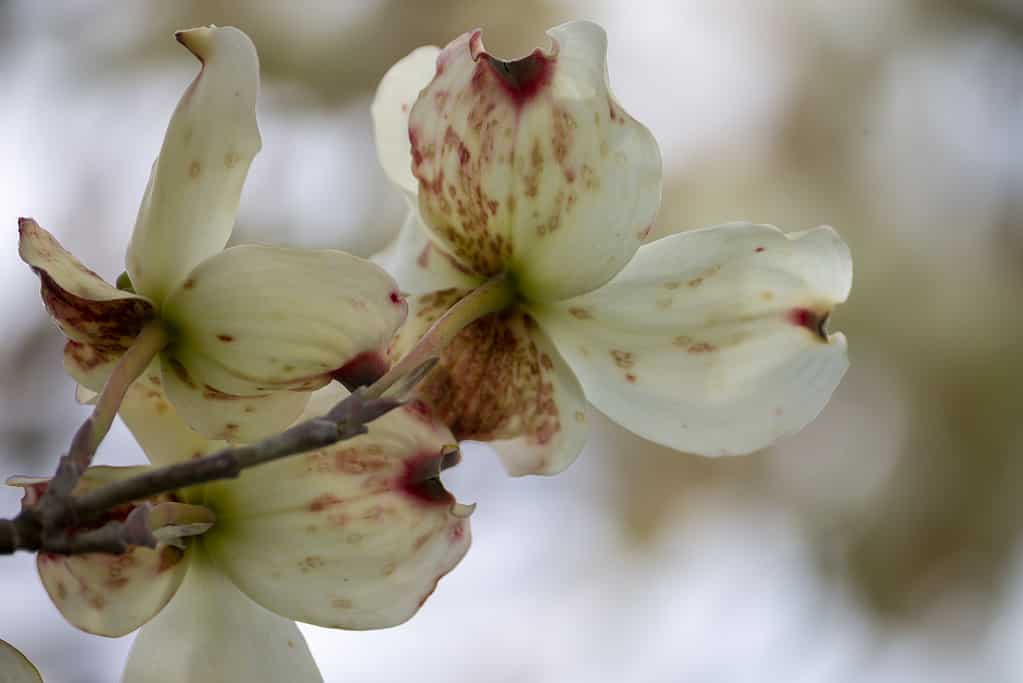
Ugly blotches on flowering dogwoods are the hallmark of spot anthracnose.
©JENNIFER E. WOLF/iStock via Getty Images
Highly active during rainy periods, spot anthracnose attacks the flowering dogwood’s leaves and twigs. In the spring, spot anthracnose spores are carried from infected trees to other trees by the rain. Spores settle into both flower and leaf buds as they begin to open. Wet weather brings about the most damage from spot anthracnose. Flowering dogwood leaves display spots of yellow or purple. In some situations, the centers of infected spots fall out, giving leaves a perforated look. Dogwood flowers become spotted and pitted.
Symptoms of spot anthracnose diminish during dry weather. Unless the flowering dogwood remains infected for a series of years, spot anthracnose won’t kill your tree. However, if you see signs of spot anthracnose on your flowering dogwood, there’s not much to be done. Fungicide sprays can be applied once a week during the budding season until the tree fully leafs out. Gather and destroy fallen leaves. They may still hold spot anthracnose spores.
13. Powdery Mildew (Erysiphe pulchra)
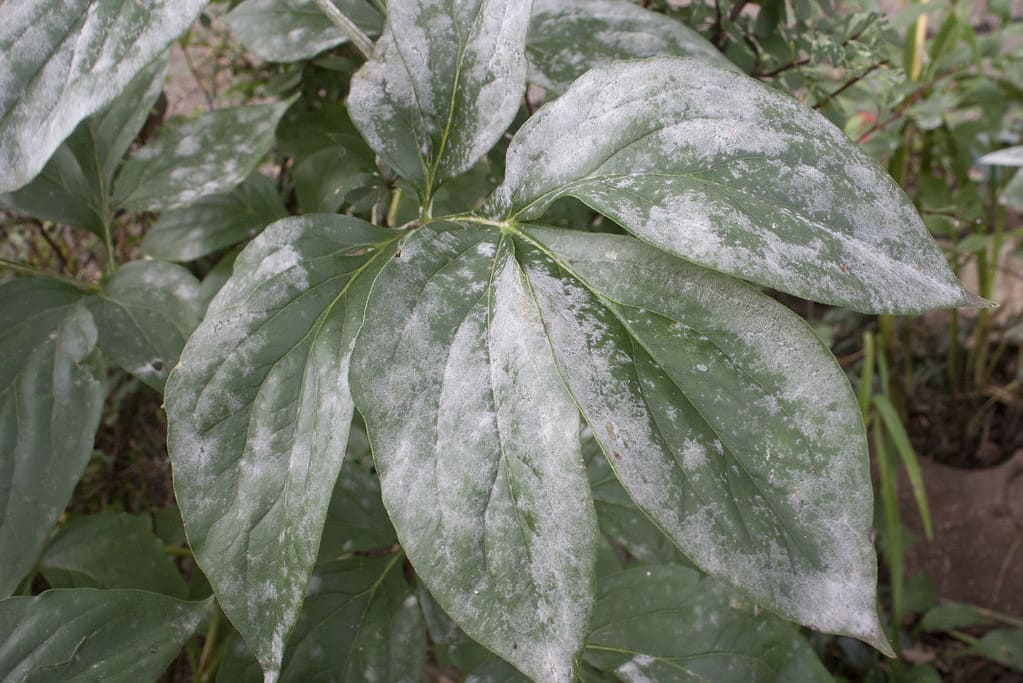
Aesthetically displeasing, powdery mildew isn’t internally invasive.
©SBSArtDept/iStock via Getty Images
A common malady for flowering dogwoods, powdery mildew is a fungal disease that attacks the plant’s leaves. Powdery mildew spores are carried by the wind. Once established, powdery mildew causes unattractive dusty white-greyish spots on the foliage. Powdery mildew patches block necessary sunlight from the leaves, disrupting photosynthesis. Leaves become malformed and, in extreme cases, turn yellow and wither.
Powdery mildew won’t kill flowering dogwoods, but it could inhibit bloom production during the next growing season. Thin out the branches to promote air circulation. Powdery mildew thrives in humid conditions. Keep the tree mulched. If desired, use a fungicide on the leaves beginning in May.
14. Cercospora Leaf Spot (Cercospora arachidicola)
Causing ugly brown spots on the leaves of flowering dogwoods, the Cercospora fungus is active during hot, humid weather. Spores are spread between trees by wind and rain. Typically, Cercospora attacks older leaves first. Spots range in color from gray to tan within a yellowish border. Left unchecked, Cercospora can grow and prematurely cause leaves to fall from flowering dogwoods. Leaf drop causes stress to flowering dogwoods, leaving the trees vulnerable to other diseases.
By itself, Cercospora is not fatal to flowering dogwoods. Because Cercospora doesn’t make its presence known until late in the growing season, fungicides are not recommended. Gather and destroy fallen leaves to reduce the chances of continued Cercospora infection.
15. Septoria Leaf Spot (Mycosphaerella populorum)
Near the end of summer, leaf spot caused by the Septoria fungus may be noticed on flowering dogwoods. These spots range in color from dark brown to purple with clearly defined borders. Inside the spots are small structures that contain spores. Septoria is spread via wind and rain. This fungus thrives in humidity. Large infestations can result in leaf drop, which weakens the flowering dogwood.
Thankfully, Septoria only causes cosmetic damage and is not infectious. Reduce the chances of further instances by raking and disposing of fallen leaves. Remove dead branches from the flowering dogwood. That will improve the airflow throughout the tree and reduce stagnant, humid areas. In the spring, fungicide may be applied to protect new growth. Check with your local county extension bureau for more information.
Summary of 15 Reasons Your Dogwood Looks So Sickly
| Threat | Source | Remedy |
|---|---|---|
| Leaf Scorch | Conditional | Keep soil moist, lay down mulch |
| Overwatering | Conditional | Reconfigure watering schedule, improve soil drainage |
| Dogwood Borer | Insect | Remove affected branches, manually destroy insects |
| Dogwood Twig Borer | Insect | Remove and destroy affected branches, apply insecticide if necessary |
| Dogwood Clubgall Midge | Insect | Remove and destroy affected twigs and branches |
| Dogwood Sawfly | Insect | Manually remove insects, apply neem oil |
| Scale Insects | Insect | Manually remove insects, spray with water or neem oil |
| Tree Aphids | Insect | Spray with water or neem oil |
| Armillaria Root Rot | Fungal | Remove and destroy tree |
| Dogwood Anthracnose | Fungal | Remove affected branches, remove and destroy fallen leaves |
| Collar Rot | Fungal | Excise infected areas or remove and destroy tree |
| Spot Anthracnose | Fungal | Remove and destroy fallen leaves, apply fungicide if necessary |
| Powdery Mildew | Fungal | Thin branches, apply mulch, use fungicide if necessary |
| Cercospora Leaf Spot | Fungal | Gather and destroy fallen leaves |
| Septoria Leaf Spot | Fungal | Remove dead branches, gather and destroy fallen leaves, apply fungicide in spring if necessary |
The photo featured at the top of this post is © Nina B/Shutterstock.com
Thank you for reading! Have some feedback for us? Contact the AZ Animals editorial team.







